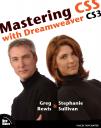This just in… the book is out!
Well, the labor of love is finally finished, and on April 11th, Mastering CSS with Dreamweaver CS3 will finally hit the bookshelves! Yes, you read that right – we did it!! It’s done!! You can buy it!! And, no, I don’t have any free copies to send you – yet! :-)
 I co-wrote the book with Stephanie Sullivan, the mastermind behind the new CSS starter layouts in Dreamweaver CS3, and although we originally “planned” on the book’s release to follow on the heals of the release of Dreamweaver CS3, we quickly found out just how difficult writing a book could be when you simultaneously have to do a “real job”. “It’ll be easy,” I said, “I’ve got tons of time to write while on airplanes, in hotel rooms, etc”.
I co-wrote the book with Stephanie Sullivan, the mastermind behind the new CSS starter layouts in Dreamweaver CS3, and although we originally “planned” on the book’s release to follow on the heals of the release of Dreamweaver CS3, we quickly found out just how difficult writing a book could be when you simultaneously have to do a “real job”. “It’ll be easy,” I said, “I’ve got tons of time to write while on airplanes, in hotel rooms, etc”.
But, I really should have known better… Most of the time that I’m on a flight, I’m headed off to do a conference presentation or a seminar roadshow. And, of course, in keeping with the motto of “keep it fresh”, I’m always tweaking files and experimenting with new ideas on the plane. Once on the ground, there’s food to be found, sports to be watched, and when in Europe, good beer to be consumed (oops, maybe I shouldn’t have mentioned those last two). And while Stephanie gamely tried to keep me on task, her own travel, speaking engagements and the need to run a business quickly made us a procrastinating “pot and kettle”.
But, we finally did it. And, quite honestly, it was worth it – the wait, that is. One of the main reasons is that we were able to really work through the examples in a thorough manner, getting in all of the info that both of us are constantly asked about during conferences. The other great news about the delay is that I was able to completely change the last chapter of the book to incorporate the latest release (1.6) of the Spry Framework for Ajax.
This is something that was weighing heavily on us towards the middle of last year. The Spry team had done an amazing job with the initial releases of the framework, however, it still had some short-comings. We wanted our book to follow the best practices not only of CSS, but also of Ajax. And the issue at the time, was the inability of the Spry framework to deliver a version of the page if Javascript was disabled or unavailable in the user agent. But the 1.6 release changed all that.
Spry 1.6 allows for the use of HTML, and more specifically, the HTML within the same page, as the data source for its enhancements. This means that we can create a page, laid out perfectly with standard CSS techniques, but then completely change or enhance the page with Ajax functionality when Javascript is available. Believe me, this is definitely one of the coolest technologies that I’ve ever worked with – and I’ve seen a bunch in over 20 years in this biz.
Anyway, we hope you enjoy the book – we’ll both be looking forward to hearing your comments (only the good ones, of course!), and if you track us down at any of the numerous conferences and trade shows that we’ll be at this year, we’d love to hear your suggestions for our next book… Wait, did I just agree to do this whole thing again?! Shoot me now!


3 Comments »